28 March 1778 Saturday
Vases, Candelabra, Grave Stones, Sarcophagi. Tripods, Lamps and Ancient Ornaments volume II
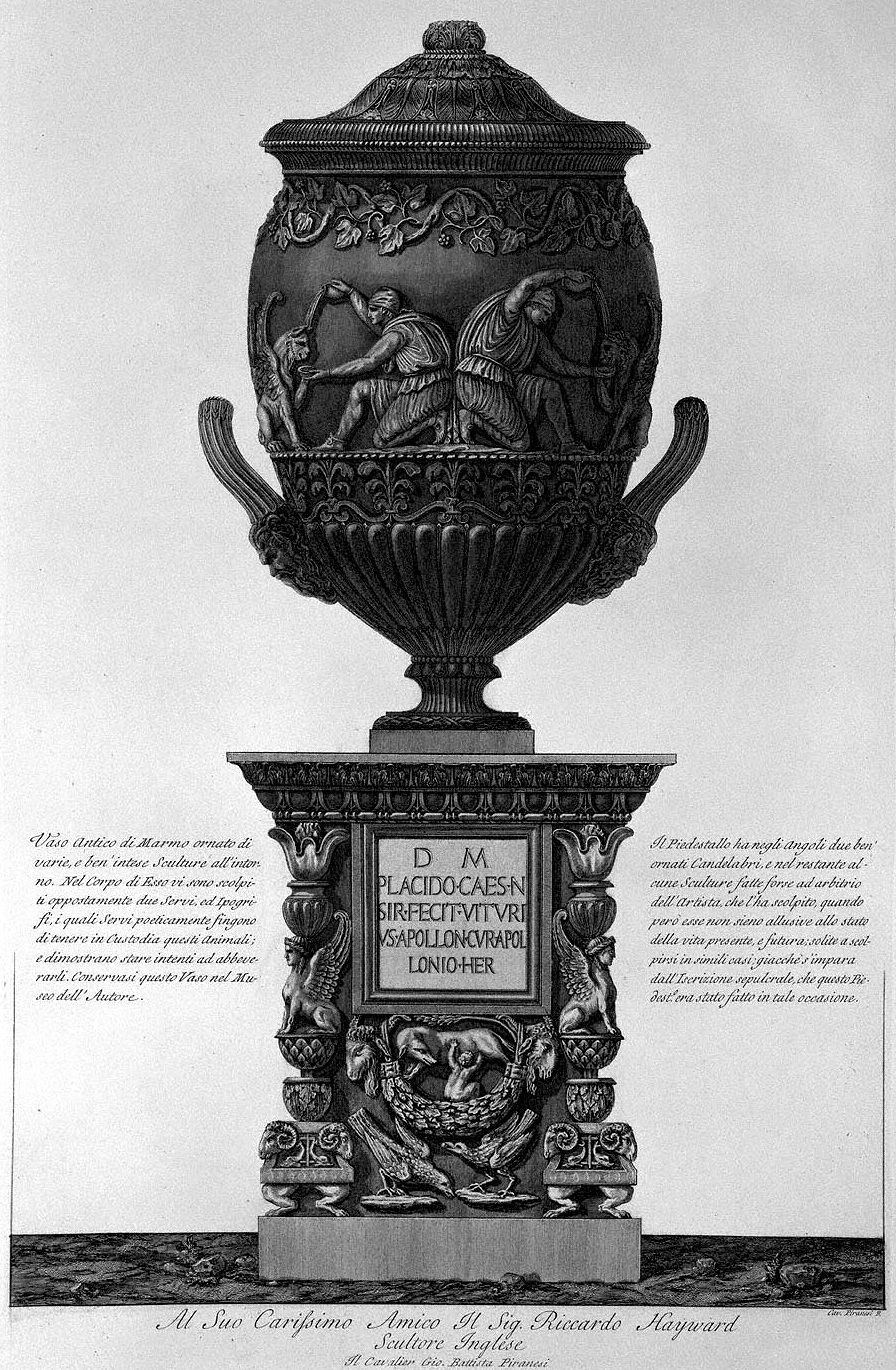
To Your Dearest Friend Mr. Riccardo Hayward English Sculptor
Cavalier Gio. Battista Piranesi
Ancient marble vase adorned with various, well-understood sculptures all around. In the Body of It there are sculpted oppositely two Servants, and Hypogriffs, which Servants poetically pretend to keep these Animals in Custody; and they show that they are intent on watering them. This Vase is kept in the Author's Museum.
The Pedestal has two well-decorated Candelabra in the corners, and in the remainder some Sculptures made perhaps at the discretion of the Artist, who sculpted it, when however they are not alluding to the state of present and future life; accustomed to sculpting themselves in such cases; since we learn from the sepulchral inscription that this Piedesto had been made on that occasion.
Cav. Piranesi F.
28 March 1783
It is in fact known that, from the year before, Francesco had begun a correspondence with Baron Carl Fredrik Fredenheim, head of the Swedish Chancellery, with the declared intention of being appointed special agent in Italy for the fine arts of the king. This happened, thanks to the intercession of the nobleman, on March 28, 1783. See 17 February and 4 April.
24-25 y.o. Francesco Piranesi 1783
Temple of Serapis at Pozzolo
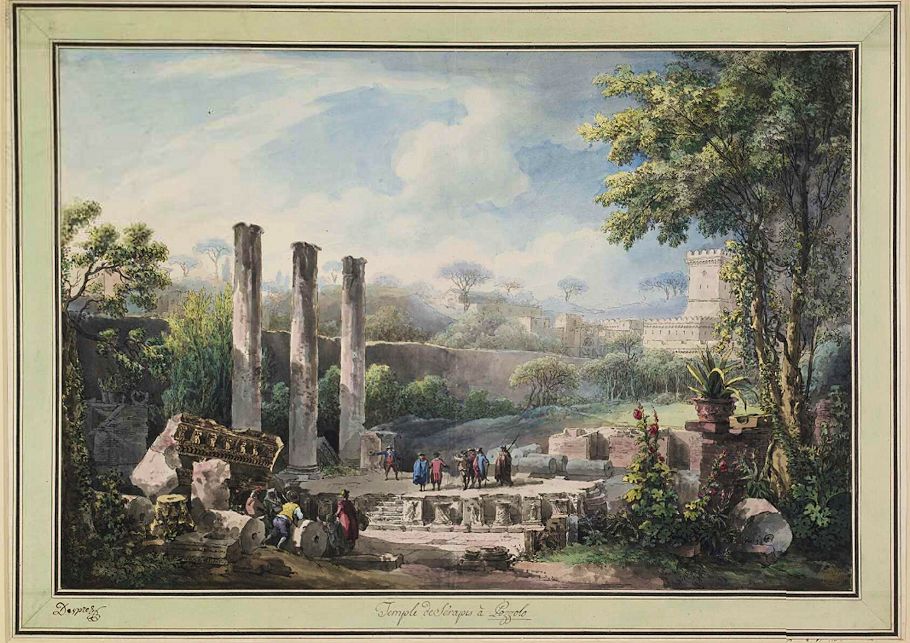
Etching by Francesco Piranesi of drawing by Louis Jean Desprez, with hand-colouring by Louis Jean Desprez.
45-46 y.o. Francesco Piranesi 1804
Calcography of the Piranesis
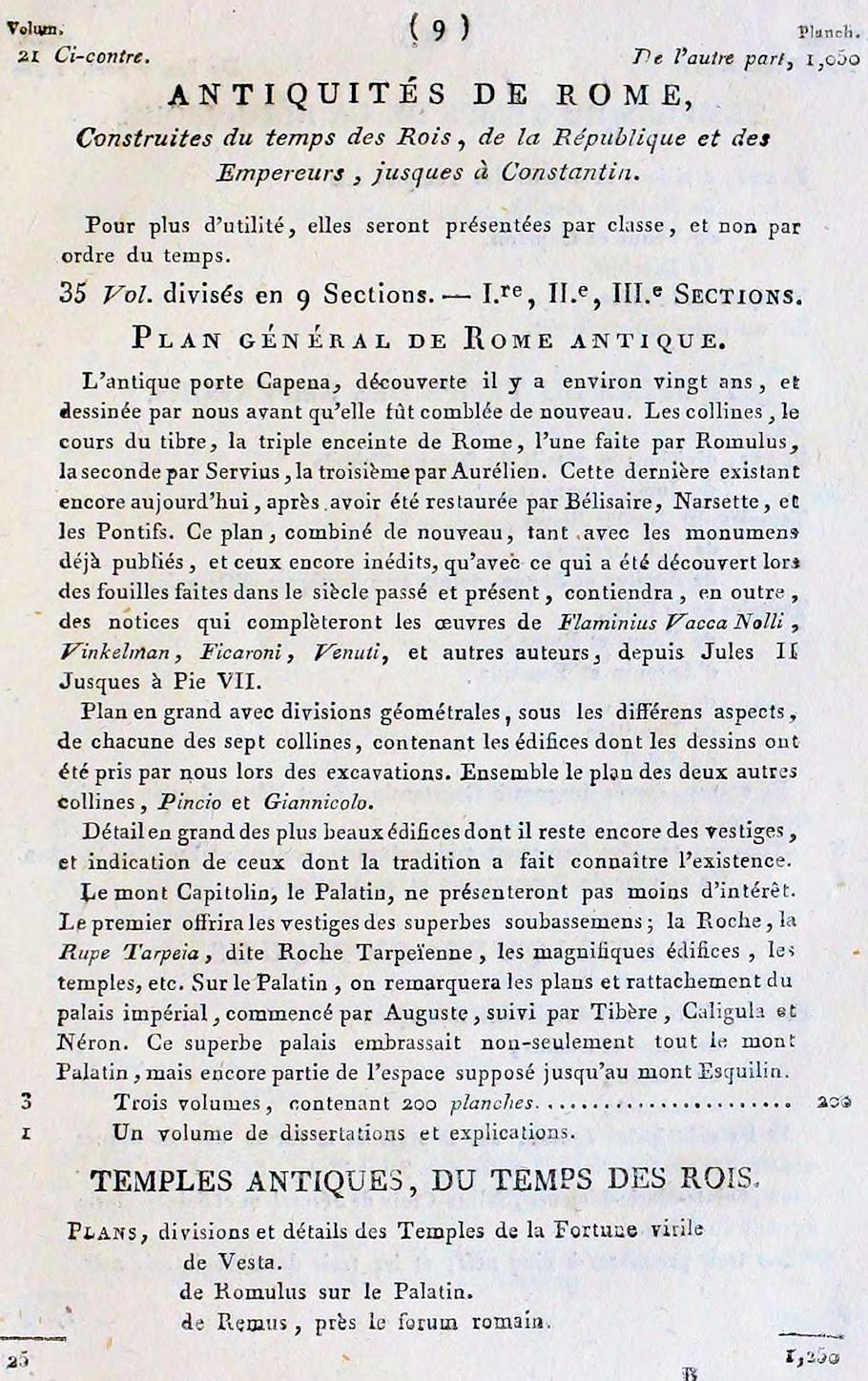
ANTIQUITIES of ROME
Built from the time of the Kings, the Republic and the Emperors, up to Constantine.
For convenience, they will be presented by class, not in order of time.
35 vol. divided into 9 Sections — I, II, III Sections.
General map of ancient Rome.
The ancient Capena gate, discovered about twenty years ago, and designed by us before it was filled in again. The hills, the course of the Tiber, the triple enclosure of Rome, one made by Romulus, the second by Servius, the third by Aurelieu. The latter still exists today, after having been restored by Bélisaire, Narsette, and the Pontiffs. This plan, combined again, both with the monuments already published, and those still unpublished, that with what was discovered during the excavations made in the past and present century, will contain, in addition, notices which will complete the works by Flaminius Vacca Nolli, Vinkelman, Ficaroni, Venuti, and other authors, from Julius II to Pius VII.
Large plan with geometrical divisions, under the different aspects, of each of the seven hills, containing the buildings from which the drawings have been taken by us during the excavations. Together the plan of the other two hills, Pincio and Giannicolo.
Large detail of the most beautiful buildings of which there are still vestiges, and Indication of those whose existence has been made known by tradition.
The Capitoline Hill, the Palatine, will not be less interesting.
The first will offer the remains of superb foundations; the Rock, the Rupe Tarpeia, known as Roche Tarpeďenne, the magnificent buildings, the temples, etc. On the Palatine, note the plans and attachment of the imperial palace, begun by Augustus, followed by Tiberius, Caligula and Nero. This superb palace embraced not only the whole of the Palatine Hill, but still part of the supposed space up to the Esquiline Hill.
Three volumes, containing 200 plates
A volume of dissertations and explanations.
ANCIENT TEMPLES, FROM THE TIMES OF KINGS.
PLANS, sections and details of the Temples of Virile Fortune of Vesta.
of Romulus on the Palatine.
of Remus, near the Roman forum.
28 March 1812 Saturday
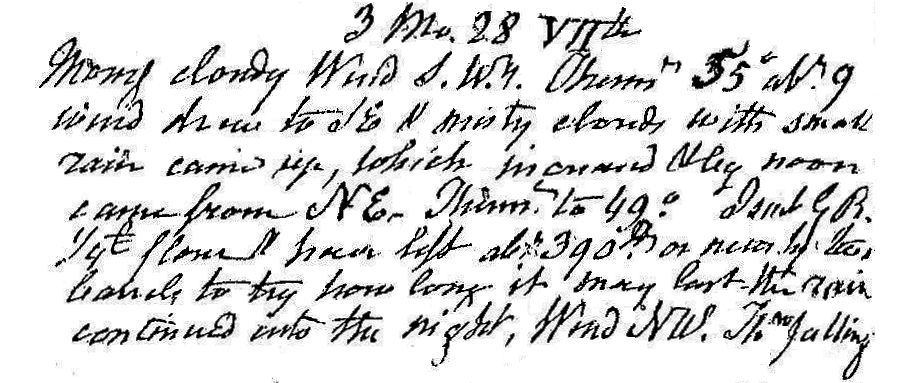
Morning cloudy, wind SWerly. Therm. 55°. About 9 wind drew to SE and misty clouds with small rain came up, which increased and by noon came from NE. Therm. to 49°. I sent GR 1/4[?] flour and have left about 390# or ...... two barrels to try how long it may last. The rain continued into the night, wind NW. Therm. falling.
28 March 2001
Duchamp striptease quondam Piranesi, even
Naumann's article is all about finding clues about meaning purposely hidden by Duchamp within his oeuvre.
Piranesi's Ichnographia Campus Martius contains a nimiety of purposely hidden clues as well.
28 March 2004
Re: aesthetic knowledge
"The punishment of the cross remained in force throughout the Roman Empire until the first half of the fourth century. In the early part of his reign Constantine continued to inflict the penalty of the cross (affigere patibulo) on slaves guilty of delatio domini, i.e. of denouncing their masters (Cod. Th. ad leg. Jul. magist.)."
--excerpt from "Archaeology of the Cross and Crucifix" in The Catholic Encyclopedia, 1908
28 March 2007
Theory Part II - Doing What I Said I Would Do...
...just ignore it all. Why should you be any different than everybody else? Although I am serious about the "convincing piece of architecture" being more virtual than anything else.
But going back to the original question of this thread, does theory today make better designers? Personally, I think teaching style and technique would make better designers, where theory applies to the various styles and techniques and not so much to forming a priori thought processes of the designer.
Most of my architecture teachers worked in Kahn's offices and/or were students of his studio at Penn.
Does Goldhagen mention Piranesi's Campo Marzio hanging over Kahn's office desk or the Gaudet volumes on the desk?
"Naturally, his thinking has foundations in architectural history. As Joseph Esherick sees it, "There is a moral injunction and an ethical character about Kahn's pronouncements. It is familiar in the writings of Julien Gaudet, whose Éléments et Théorie de l’Architecture in four volumes (1870-1880) posits that the elements of architecture are not the ancient orders but they are windows, walls, floors, and light. The idea that a wall wants to be a wall and the idea of master spaces and slave spaces are both in Gaudet. I remember," Esherick adds, "that the prominent thing on Kahn's desk when I first went to meet him in the late 50s was a copy of Gaudet's old testament.""
--C. Ray Smith, Supermannerism: New Attitudes in Post-Modern Architecture (1977), p. 82-3.
...and speaking of random tangents
10:43 EST Some sort of hawk or eagle gliding over Quondam Ury.
Remember to look for any references to John James Audubon in Miers Fisher's 1804 journal.
So it turns out that Miers Fisher did know William Penn IV--a great-grandson of Philadelphia founder William Penn. All I know so far though is that Miers shared a coach with Penn and his wife between Doylestown and Abington mid 1812. Perhaps a great-grandson or two of founder William Penn were once at Ury after all.
Finished digitizing a 1839 map of what is now Northeast Philadelphia. There are more 'Indian' trails around here than I previously thought, and I hadn't realized before that Indian trail-Oxford Ave is a fairly consistent exact north-south trajectory. And Cottman Ave. and Castor Ave. correspond directly to lines on the 1687 map of Pennsylvania--their orthogonal intersection even makes a kind of cardo and decumanus. There's an aerial view of Cottman and Castor in The Harvard Design School Guide to Shopping, p. 780 toward the upper left, Bustleton Avenue along the bottom of the page is an old Indian trail.
Once you study them, you find that the "Indian" trails within Philadelphia are not random tangents at all. Certainly not as random as the lines on the 1687 map of Pennsylvania. (Cottman Ave. is the parallel line to the left of the planned Susquehanna Road.)
Theory Part II - Doing What I Said I Would Do...
If anyone here thinks that I am opposed to or think lowly of "getting ideas from misreading a text," then you have jumped to a wrong conclusion.
What I do find fault in is Tafuri's interpretation of Piranesi's Campo Marzio. And since this faulty interpretation is a crucial element of Tafuri's "historical-critical project"/research, I then see the need to re-evaluate Tafuri's overall theory. Moreover, that what Piranesi actually did with the Campo Marzio is indeed the opposite of Tafuri's interpretation of what Piranesi did with the Campo Marzio can well suggest that Piranesi's Campo Marzio shouldn't even be within Tafuri's overall theory.
And then there is Peter Eisenman utilizing and teaching Piranesi's Campo Marzio based on (really just repeating) Tafuri's misinterpretation of Piranesi's Campo Marzio. Furthermore, Eisenman has not contributed any new insight regarding Piranesi's Campo Marzio, and, if anything, more just tailors Tafuri's misinterpretation to suit his own design methodology. What I see fault in here is Eisenman's suggestion that his method is based on what Piranesi did within the Campo Marzio, where, in fact, Eisenman's method is based on Tafuri's misinterpretation of what Piranesi did. Again, it is more the case that what Piranesi did within the Campo Marzio has very little to do with Eisenman's method.
At this point all I can say is that I personally have learned a great many positive things directly from Piranesi's Campo Marzio itself, and I've learned a great many negative things from what Tafuri thought Piranesi did within the Campo Marzio.
Theory Part II - Doing What I Said I Would Do...
Eisenman doesn't misread Tafuri at all. And judging by Tafuri's interpretation, he didn't even bother to read Piranesi's Latin labels within the Ichnographia Campus Martius. Misreading isn't even the issue here. It's more the lack of reading altogether.
28 March 2012
Re: Traditional Architecture
"But Lou and Arthur were on my roof talking, so that Lou could meet this interesting South African architect, which was very nice. I was a young widow living in Philadelphia and living at Penn. And I seemed to have been an unwitting member of all sorts of situations, which I didn't know what was happening, but had some intuitive feelings of things happening. Which were men--married men and unmarried men--who were seeming--it seems as if I had figured in their lives in some sort of way that I wasn't quite sure of, and I didn't want to know about. That is, I wasn't interested in the side of being a young, single woman, experienced--I had been married already--and of interest to a range of different people on the faculty and around. So within that sort of context, Lou was interested in me in that way, too. It's something a woman professional learns about. Men have other interests in her than as a professional. Oskar Stonorov was like that. I thought I was being invited to dinner to talk about Le Corbusier, and I discovered that that wasn't his agenda. But it had been my agenda. When I met Oskar Stonorov, I thought of him as the American version of Ernö Goldfinger, and Ernö Goldfinger was an English version of Oskar Stonorov. They were very similar people. And sure enough, Oskar Stonorov suggested--he said, "Oh, yes. I remember Ernö Goldfinger. He was the one who couldn't draw." [laughs] Just the sort of thing Ernö would have said. Anyway, what I'm saying is nothing happened in any of these situations, because I was just not--that wasn't my role in life. In other words, if I got invited for dinner by Stonorov, who had a wife, and I thought I was being invited to talk about Le Corbusier and architecture, and I found that that probably wasn't what he had in mind--what he had in mind, I would not let become very explicit. And there was something like that with Lou, too. But what are you going to say? Later he took up with Harriet, and he had been with Ann [Tyng]. He didn't manage to have a relationship of any sort of sexual nature with me, though he would have liked to. And I was just the kind of person he was attracted to. Now, that's one of the sort of things I should probably restrict. It's pertinent, but it isn't. I never know quite whether those things..."
--Denise Scott Brown
28 March 2013
Is drawing dead?
Word processing doesn't make me less considerate of what I write, in fact, it gives my words alacrity. The same can be said of what CAD gives my designing.
28 March 2016
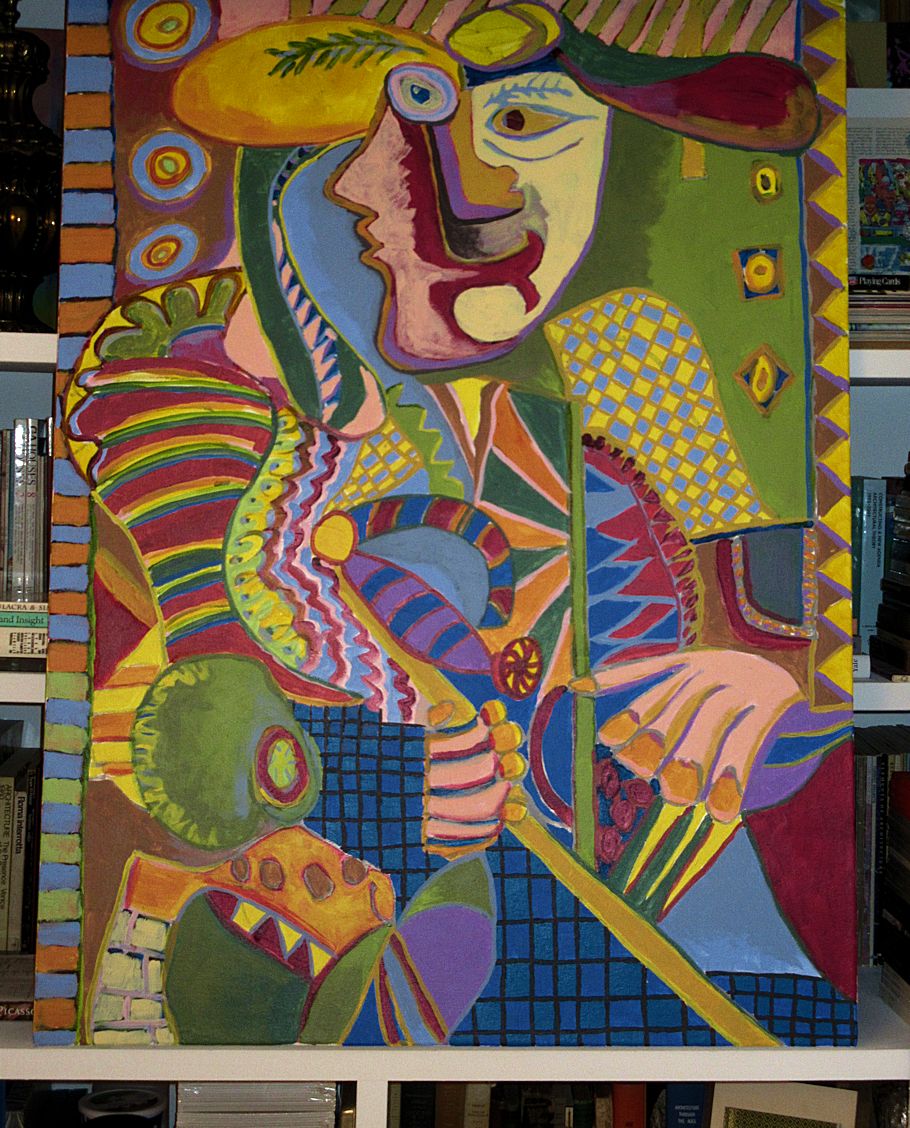
28 March 2018
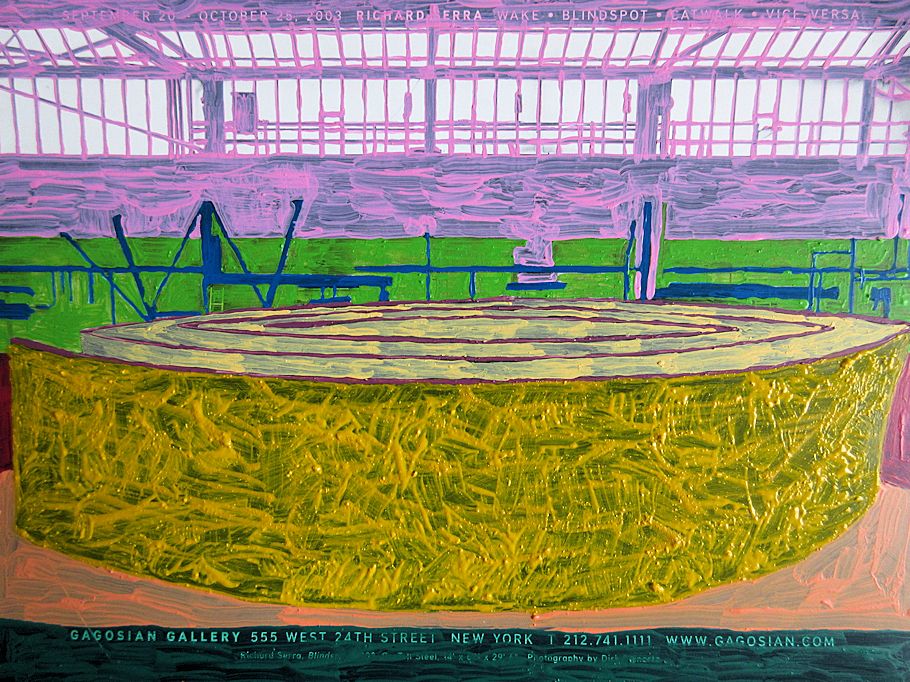
28 March 2023 Tuesday
An email from academia.edu, which I read shortly after 7pm, informed me that Heather Hyde Minor uploaded a new paper, and thus I learned of the 26 March 2023 publication of Piranesi@300. Sadly, I am not among those celebrating Piranesi's birthday, but I am cited within Piranesi@300's "Bibliografia."
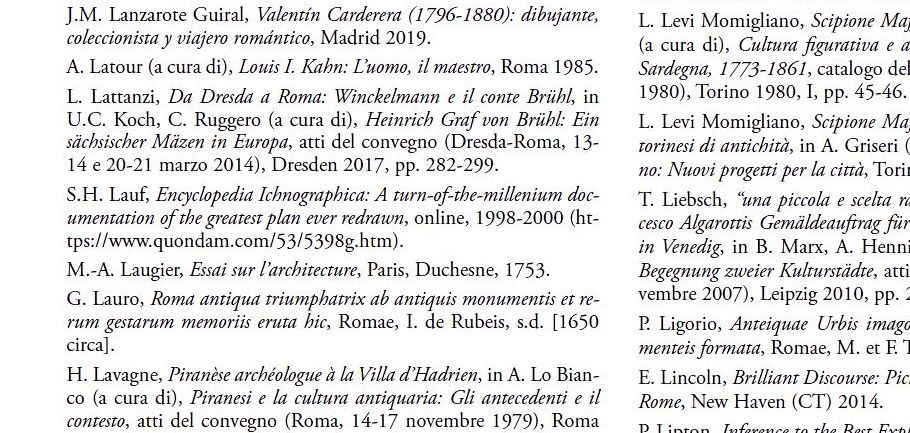
www.quondam.com/53/5398g.htm is an obscure link to Encyclopedia Ichnographica which is otherwise freely available at www.quondam.com/e25/index.htm, and has been available at that web address since 2018.
Anyway, it now seems all the more appropriate that on 26 March 2023, while Mario Bevilacqua announced the publication of Piranesi@300, I was writing:
"I now realize that making actual history, perhaps even intrinsically, comes with the task of fixing the existing history. The fixed history is the aftermath of the new history. Aftermath in the sense that new history manifests a significant unpleasant event for existing history, catastrophic, even, within the wake of the new history's epicenter."
|